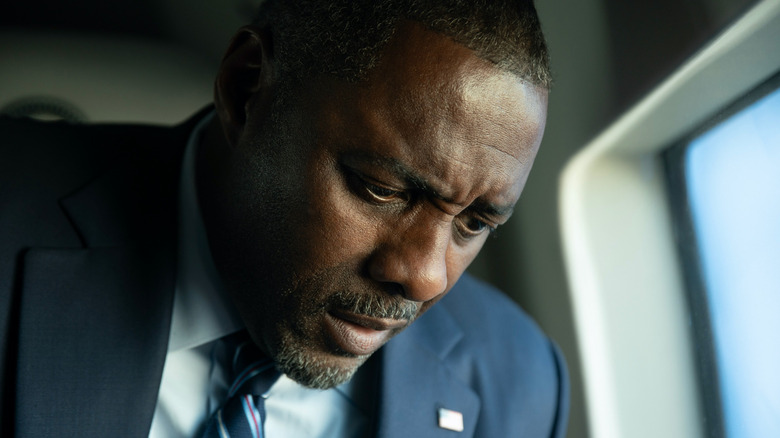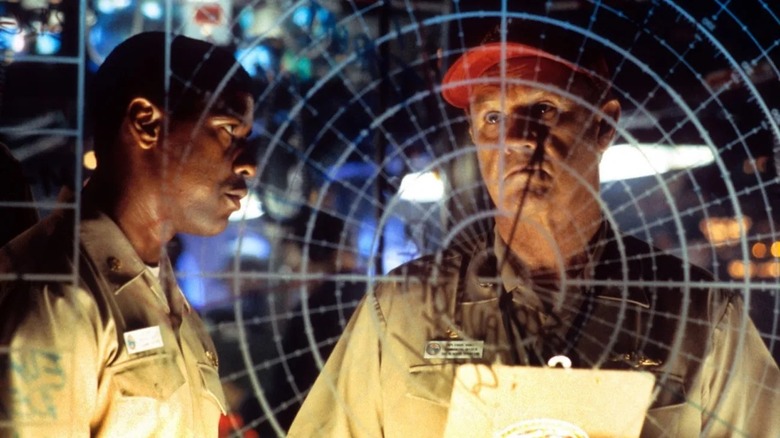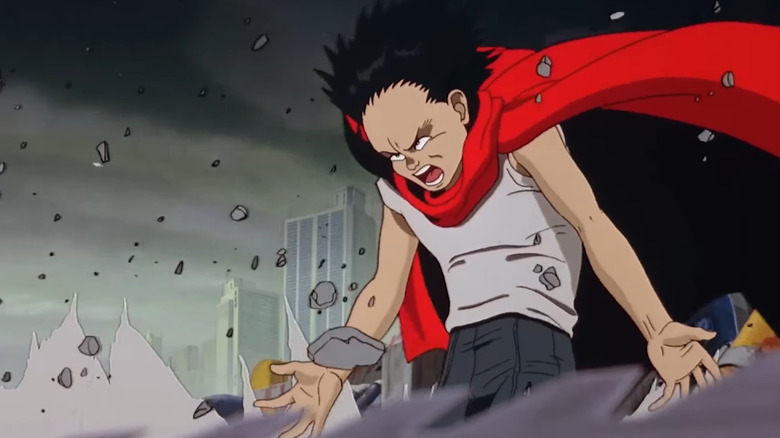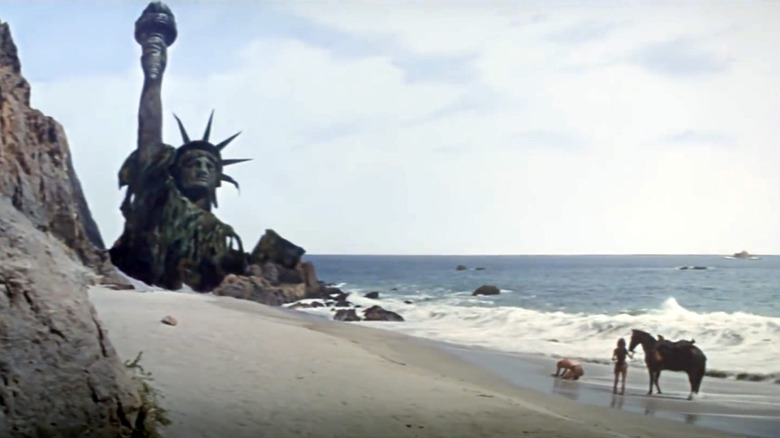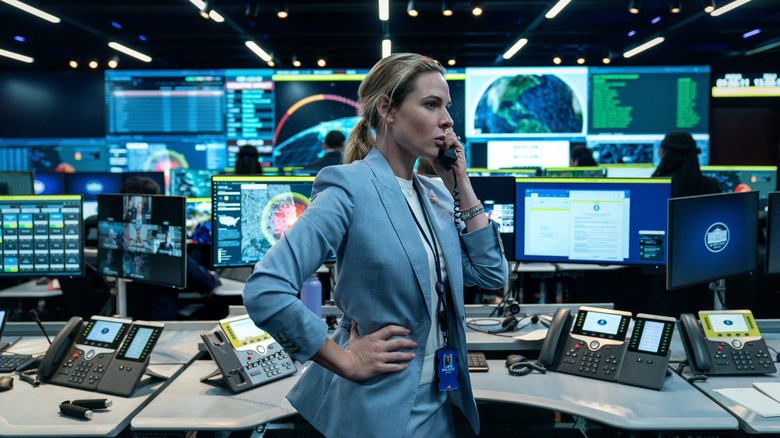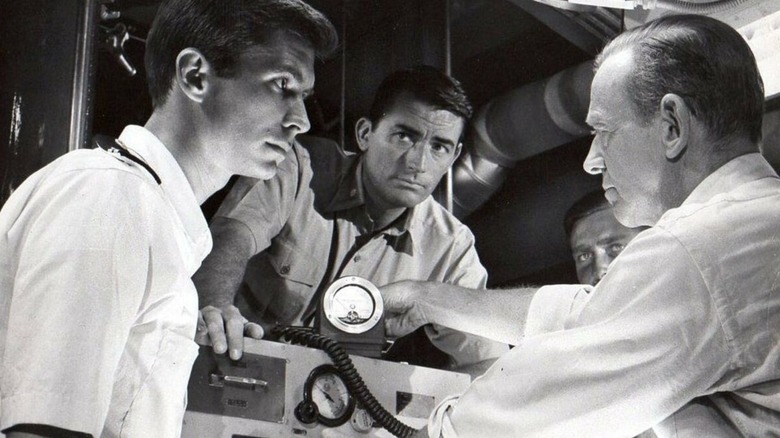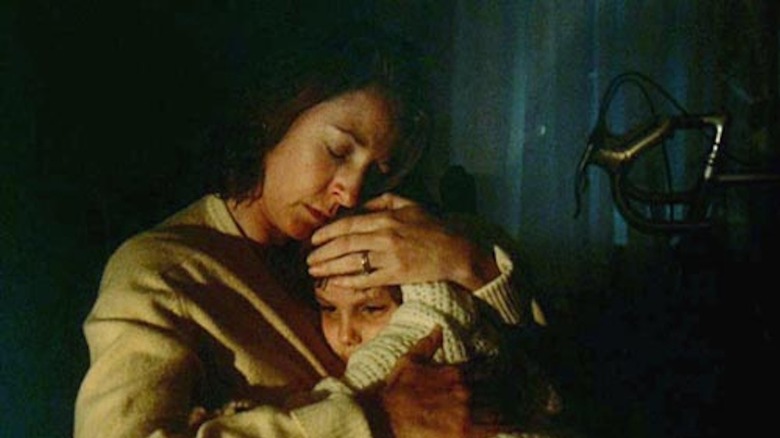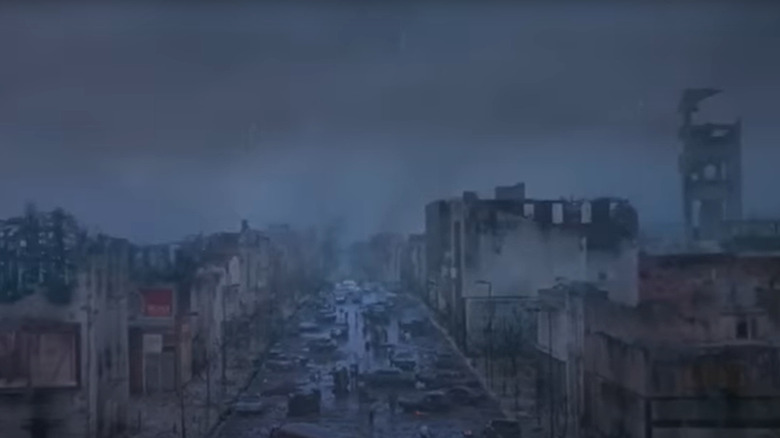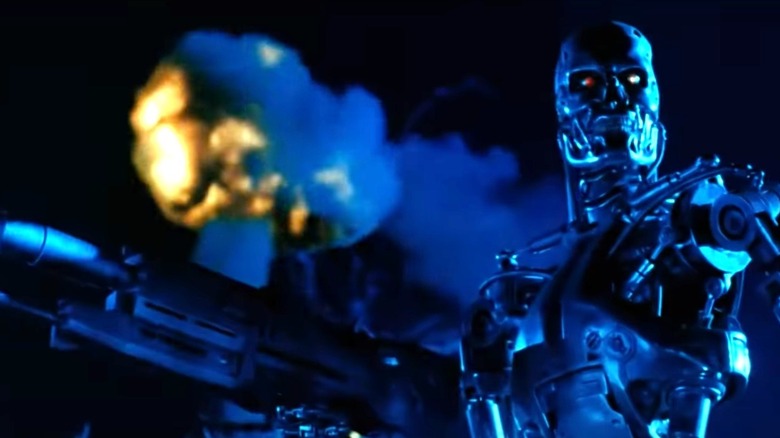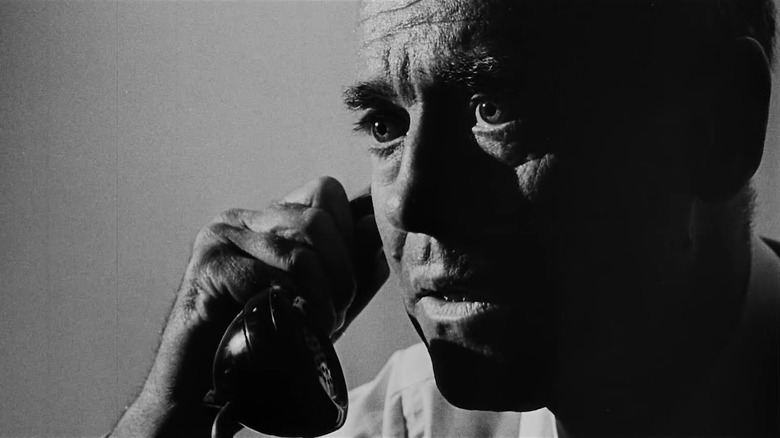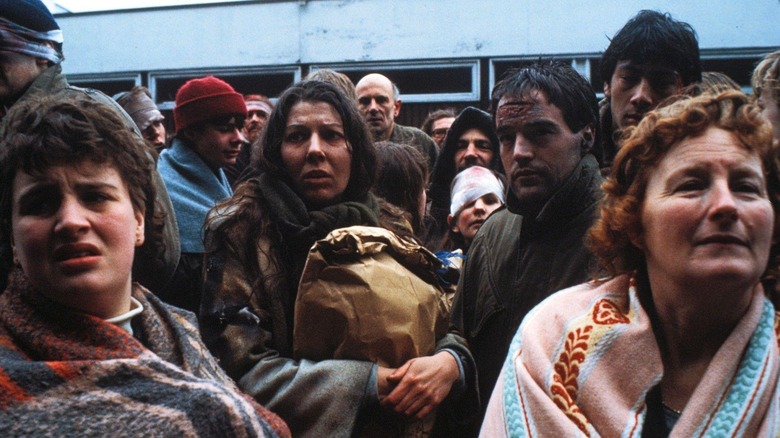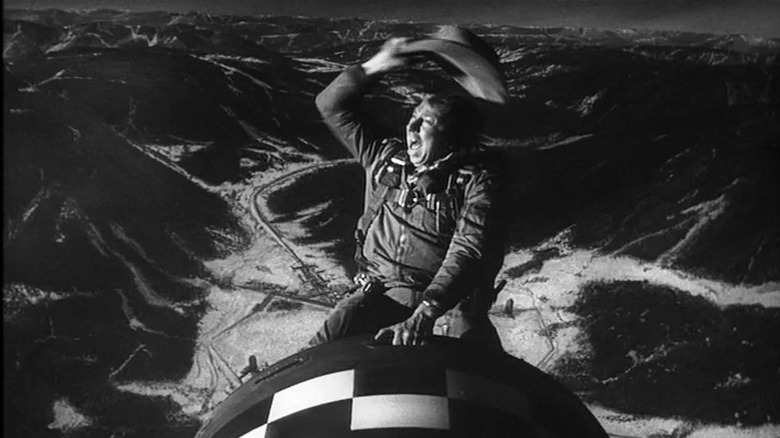12 Best Movies About Nuclear Apocalypse, Ranked By Doom
Kathryn Bigelow's terrifying new thriller "A House of Dynamite" gives us a minute-by-minute breakdown of how various people working for the U.S. government might react if a nuclear missile was on its way. Noah Oppenheim's intense script hammers the point home again and again that there are no good solutions to this problem, and that the very existence of nuclear weapons is something that will doom us all. With "A House of Dynamite" in select theaters before heading to Netflix this month, we decided to rank some of the best nuclear war movies by how unsettling they are in their depictions of annihilation.
12. Crimson Tide
The Glasnost era was supposed to sap moviegoers' interest in nuclear war dramas and thrillers, but, in the spring of 1990, folks nevertheless lined up for the rogue Russian submarine actioner "The Hunt for Red October." Mostly, though, action filmmakers adapted to the changing world by making hostage-taking terrorists the bad guys (and not always in a culturally sensitive manner), while dealing with the threat of nuclear war as an advanced tech mishap. Still, people love submarine movies.
Fortunately for these fans, director Tony Scott and screenwriter Michael Schiffler were paying attention to the news in the mid-1990s when they crafted the taut-as-hell "Crimson Tide" (one of Scott's very best movies). They used their imaginations to believably expand the First Russo-Chechen War into a full-on Russian Civil War where an ultranationalist leader is able to take control of a nuclear missile instillation. This thrusts the men of the USS Alabama out to sea, where they have orders to launch a preemptive nuclear strike if the Russian leader begins fueling his missiles. These orders are given, but as the ship prepares to fire, another order comes in. Alas, an attack on the Alabama damages the ship's radio, so they are left with an incomplete order. This incites a battle of wills between Captain Frank Ramsey (Gene Hackman) and his XO Ron Hunter (Denzel Washington); the former wants to follow the first order, while the latter demands they wait for confirmation on the second order — because if that order is to stand down, they'll be starting World War III for no reason.
Hackman and Washington are on their A-plus games, but, in today's conflict-heavy times, the thought of a mistaken launch that could hasten armageddon gives the film its sobering center. (Jeremy Smith)
11. Akira
Katsuhiro Otomo was not subtle when he decided to open "Akira," a feature film adaptation of his own manga of the same name, with a nuclear bomb exploding over Tokyo. On the surface, this hugely influential dystopian sci-fi anime movie may be about teenage biker gangs with sweet rides, creepy esper kids and a teenager with anger issues becoming a blob, but every aspect of Otomo's monumental epic touches on fears of nuclear armageddon. This is a movie about a world that has failed children, a world where scientists discovered the power of god and did everything they could to weaponize it — even after it already destroyed the world. There are never-ending protests and riots against the government, religious cults calling for the end of times, shadowy organizations shooting and kidnapping people in the streets, and esper kids working for the government.
For the two hours of runtime after the initial bomb explosion, Otomo never lets the audience forget what is at stake, that the world has already ended and even so the people in charge are toying with bringing armageddon back. This is a movie not about preventing armageddon, but about preparing for one. Society is in a constant state of decay. Corruption is rampant, malice and violence run wild. The end of days is inevitable (again), and there's a deep sense of despair and cynicism in the story, that it's futile to try and stop it. (Rafael Motamayor)
10. Planet of the Apes
"Planet of the Apes" only truly shows its nuclear card at the very end, but it does re-contextualize everything that came before. When time traveling astronaut Taylor takes a look at the Statue of Liberty and realizes he's been on Earth all along, he falls to his knees and curses humanity, with the despair and pain in Charlton Heston's performance making this one of the best movie endings of all time. It's not just a twist ending meant to shock audiences, but a final twist of the knife that this horrible place was not some far away nightmare, but our reality — this is what we will do to our home. Seeing one of the most recognizable images of the modern world, the Statue of Liberty, half destroyed and buried in sand, shows the power of nuclear armageddon and of our own hubris.
Even before the twist ending, we had already seen the horrors of a post-nuclear world. Not only in the fact that apes are the dominant species and humans devolved into mute brutes, but the vast, desolate landscapes we see all along, replacing whatever beauty was once there. Taylor says near the start of the film that he hopes somewhere in the universe there's something better than man. The ending shows that no, there isn't. Earth is what we've got, and we nuked it all to hell. (Rafael Motamayor)
9. A House of Dynamite
Probably the only far-fetched aspect of "A House of Dynamite," Kathryn Bigelow's feature-length exploration of what would happen in the event of an impending nuclear missile strike on the continental United States, is how it presupposes that every ranking member of government in a position of power would be calm, measured, and capable grown-ups you could trust in a crisis. Apart from that pie-in-the-sky fantasy, however, the rest of the film plays out like something straight out of our collective Cold War nightmares. Captured in full documentary-like precision, "A House of Dynamite" lives up its billing as a relentless anxiety attack about our worst fears fully realized. An intercontinental ballistic missile of unknown origins is headed straight for the city of Chicago and, despite decades of wargames and doomsday planning for this exact scenario, nothing in human history could truly prepare us for this outcome.
In the hands of Bigelow, "A House of Dynamite" captures all the horror and helplessness that entire generations lived through during the peak of Cold War tensions. Politicians are asked to make horrible decisions balancing millions upon millions of lives, obscure experts lower down the chain of command become the most important people in the world in a manner of hours, and the fates of entire nations suddenly rest on a small circle of soldiers nobody will ever know about. All of this unfolds with matter-of-fact inevitability, which only makes it all the more unnerving. It doesn't get much more terrifyingly realistic than this. (Jeremy Mathai)
8. On the Beach
In Stanley Kramer's "On the Beach," the human race is already on the brink of extinction. The last known survivors in Melbourne are in staunch denial of imminent doom, as they're graced by an unlikely ray of hope that all is not lost. As romance blooms between a submarine commander (Gregory Peck) and a socialite (Ava Gardner), the inescapable shadow of fatalism looms over everyone's desperate need to cling to mundanity.
There are no dramatic nuclear explosions or images of total annihilation in "On the Beach," but the hopelessness of living in an irradiated world is conveyed through morbid conversations and wordless glances. There are attempts to drown these anxieties in passion, grit, and libation, but nothing proves effective in the face of death knocking on the door.
The most devastating gut-punch is delivered once our survivors realize that the so-called miracle that was supposed to save them is a cruel joke, taking the form of a coincidental mimicry of Morse code. The pained smiles on everyone's faces tell us everything we need to know: the radiation levels haven't dispersed, and there's no way to evade the nuclear fallout heading their way. "There isn't time. No time to love... nothing to remember... nothing worth remembering," Gardner's Moira muses, cementing the tone of bleak gloom that the story ends on. These vivid images of hapless nihilism stay with you long after the credits roll, as if urging us to avoid such an alarming fate while we still have time. (Debopriyaa Dutta)
7. Testament
Filmed for PBS' "American Playhouse," Lynne Littman's "Testament" eschews the hellfire and mushroom clouds of Anime and places us in a small suburban town outside of California's North Bay Area, where the seemingly happy Wetherly family have their daily routine thrown horrifyingly out of whack when a newscast interrupts "Sesame Street" with panicked news of nuclear explosions on the East Coast of the United States. Within seconds a blindingly bright light illuminates the Weatherly's living room. They all seem fine, as do their neighborhoods, but all communication to the outside world has been lost. When a local ham radio operator tries to make contact with major cities like San Francisco, he is met only with static.
Carol Weatherly (a magnificent Jane Alexander) is at first primarily concerned with the well-being of her husband (William Devane), who works in San Francisco. Gradually, as his return seems increasingly unlikely, she turns her attention to the health of her children, who, one by one, are afflicted with radiation sickness. It quickly becomes clear that everyone in this community — and probably everyone on the planet who wasn't in a bunker — will die from this poisoning. Littman does not offer the viewer false hope. Society has collapsed, and, by the end of the movie, all anyone can do is draw on whatever strength their loved ones have left as they wait their turn to draw their last breath. "Testament" will break you, which is Littman's none-too-subtle point. Could you bear to see your family and friends suffer like this because superpower leaders lost their minds? Because this is what it will look like for people outside of directly targeted areas. This is one of the few movies that have ever made me ugly cry. Steel yourself. (Jeremy Smith)
6. The Day After
Nicholas Meyer is primarily known for directing "Star Trek: The Wrath of Khan," but the most effective offering in his oeuvre is a made-for-TV film that preys on fears that felt all too real in 1983. "The Day After" tells the story of nuclear fallout in the United States, stemming from a conflict with the Soviet Union. Back then, relations between America and their Soviet counterparts weren't exactly friendly, but "The Day After" actually played a part in making them better.
"The Day After" taps into concerns pertaining to nuclear anxieties and the Cold War, but the story takes its time getting to the horror. The early scenes chronicle several residents in Missouri as they go about their lives, reluctant to admit that a nuclear blast will occur. Television and radio news reports indicate that relations between the Americans and Soviets are volatile — but surely no government would act on their most extreme impulses, right? Wrong.
The creative decision to focus on regular people makes the horror in "The Day After" more effective. These folks could be our friends and neighbors, so it's disturbing to watch them go through this ordeal — and that's putting it mildly. "The Day After" shows a nuclear fallout where men and children are vaporized, cities are flattened, animals can't escape, and the Earth is poisoned. What's more, it portrays these atrocities with so much solemnity that President Ronald Reagan took notice, prompting him to sign the Intermediate-Range Nuclear Forces Treaty a few years later. "The Day After" is a powerful flick — and a great argument for opposing nuclear weapons. (Kieran Fisher)
5. Terminator 2: Judgement Day
The "Terminator" franchise is the premier blockbuster franchise when it comes to exploring nuclear war. It combines that apocalypse with another technology that might spell our doom, artificial intelligence, because automated missile control system Skynet became sentient and nuked the world. To ensure this Hell of its making comes to pass, it sends robotic Terminators back in time to eliminate (relatives of) John Connor, future leader of the human resistance.
While this future is integral to each "Terminator" movie, the one that most terrifyingly explores a nuclear apocalypse is "Terminator 2: Judgment Day." The movie opens with people going about their lives — adults packed in freeway traffic, children playing on swings — until it all disappears in a flash. Smash cut to 30 years later where that city is now a pile of bones and rubble, trampled over by Skynet's tin soldiers.
Set in 1995, "T2" shows a world where Judgment Day is imminent but few realize it. Sarah Connor (Linda Hamilton) has a nightmare where she screams from behind a park's chain link fence at a version of herself, blissfully unaware of the coming doom, playing with children on a playground. Then the nukes fall. Director James Cameron shows the terrifying scope of the blast on both a macro (Los Angeles' skyscrapers tumble over like tinfoil) and micro scale (Sarah is cooked alive, leaving a charred skeleton).
Yet "T2" is also filled some immediate post-Cold War optimism. In the end, Judgment Day is averted, and Sarah now dreams of a future when men learn not to destroy themselves. (Devin Meenan)
4. Fail Safe
Sidney Lumet's "Fail Safe" was released the same year as Stanley Kubrick's "Dr. Strangelove," aka the more famous doom-laden nuclear movie from 1964. However, Kubrick's film uses comedy to examine fears related to the Cold War and global nuclear superpowers, while Lumet's film is a nail-biting thriller that wants to depress viewers — and it does so with aplomb.
"Fail Safe" tells the story of a technical malfunction that sends American nuclear bombers toward Moscow, leaving everyone powerless to stop the city from being blown to smithereens. In an attempt to avoid an all-out nuclear war, the President (Henry Fonda) and the Soviet leader come to a grim compromise: destroy New York City and obliterate all of the unsuspecting, innocent citizens who don't deserve it.
America ultimately agrees to Russia's proposal, and we see regular folks going about their days as their countdown to extinction begins, which is the most chilling part of the movie. "Fail Safe" doesn't need grandiose special effects to convey the horrors of a nuclear fallout — it does so by showing children playing on the streets and people walking their dogs as the jets arrive. Moral of the story? Innocent people (and animals) are the ones who suffer most in nuclear war, all because of incompetent and/or malicious leaders insist on having bombs at their disposal. (Kieran Fisher)
3. Threads
Conceived in response to late-Cold War escalations and growing public concern in early '80s Britain, Mick Jackson's "Threads" holds a reputation as one of the scariest films ever made. For once, that title is not hyperbole; Jackson had previous researching thermonuclear war and the potential aftermath, and, teaming up with writer Barry Hines ("Kes"), set about creating an unflinchingly realistic portrait of a nuke falling on Sheffield, UK.
Hines' natural ear for Yorkshire dialect and Jackson's kitchen-sink approach adds authenticity in the opening act as people go about their day-to-day lives with half an ear on an escalating crisis in the Middle East. When the unthinkable happens and the bomb drops, the low budget effects do a shattering job of depicting the devastation and the sheer terror of the ill-prepared citizens. But the worst is still to come; "Threads" continues for more than a decade after the attack, charting the breakdown of society and the survivors' descent into subsistence-level squalor in a new Dark Ages.
The first TV broadcast of "Threads" shook Britain to its core and was dubbed "the night the country didn't sleep;" it has only been shown a few times on UK screens since. It pushed the envelope for nightmare-fuel imagery, but the most chilling thing is the documentary-style delivery and Jackson's refusal to provide even the merest glimmer of hope. Instead, he opts for abject despair, surely the only responsible approach when it comes to tackling the very real threat of nuclear conflict. Bleak, matter-of-fact, and all too convincing, "Threads" has lost none of its formidable power over the decades, and its grim message lingers long after the stark frozen scream that concludes the film. (Lee Adams)
2. Oppenheimer
"When I came to you with those calculations, we thought we might start a chain reaction that would destroy the entire world [...] I believe we did." Rarely before has a single exchange of dialogue summed up the greatest accomplishment and greatest failing as a human race. When Christopher Nolan announced his intentions to make a biopic about J. Robert Oppenheimer, not even his most loyal fan could've envisioned just how thoughtfully — and damningly — the filmmaker would bring the (in)famous historical figure to life in all his complexity. The idea of doing justice to a suspected Communist and a lover of science who used his unparalleled genius to construct the deadliest weapon we'll ever see, capable of ending all life as we know it? That's a lot to ask of any one film, but 2023's "Oppenheimer" proved beyond a doubt that even mass entertainment can contain multitudes.
Both a blockbuster-sized sensation and a thoughtful, adult-minded drama about the man singlehandedly responsible for our current atomic age, "Oppenheimer" stands as one of the very best movies about the nuclear apocalypse ever made. It shines a light on exactly the web of politics, hypocrisy, and self-serving justifications required to embark down a path as dark as this one. And when "Oppy" finally wields nature against itself and demonstrates the terrible potential of the atomic bomb, the spectacle that follows is as sickening and stomach-churning as anything Nolan has ever depicted on screen before. (Jeremy Mathai)
1. Dr. Strangelove
Like its full title, "Dr. Strangelove or: How I Learned to Stop Worrying and Love the Bomb," suggests, Stanley Kubrick's pitch-black political satire makes no bones about its themes of nuclear devastation. In fact, the movie doesn't really give any indication that General Ripper's (Sterling Hayden) paranoia-driven plan to launch a rogue nuclear attack against the Soviet Union could result in anything other than mutually-assured destruction.
Every element of the plot is a step on a march toward the world's inevitable end, and few of the characters we meet on the way inspire confidence toward any other result. While the movie's tight script and Peter Sellers' triple roles offer many moments of levity, true hope is rarely on the menu — and even when there's a glimmer of it, the broken radio of a bomber plane soon crushes it. More often than not, the events that unfold are relentlessly dark, even before everyone finds out about the Soviets' automated doomsday device response to the impending attack.
As its endgame nears, "Dr. Strangelove" throws its last threads of subtext in the nuclear wind. When Major Kong (Slim Pickens) rides the fateful nuclear bomb toward its target like a rodeo horse, the movie has already conditioned the helpless viewer to accept the end of the world as its natural conclusion. The famous closing montage of explosions set to the ironic tune of Vera Lynn's 1953 classic "We'll Meet Again" is a vision of global nuclear destruction made art. There have been many other depictions of total nuclear apocalypse, but only "Dr. Strangelove" uses the mushroom clouds to build a monument for the greatest horror of them all: humanity's own idiocy. (Pauli Poisuo)
